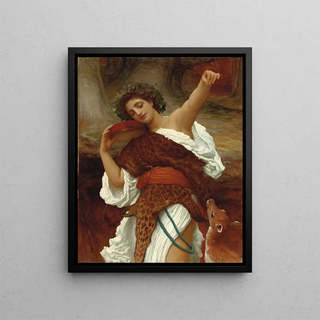Art print | Bacchante - Frederic Leighton Source: Reproduction | Bacchante - Frederic Leighton


View from behind

Frame (optional)
Bacchante Art print - Frederic Leighton – Captivating Introduction
Frederic Leighton's "Bacchante" is a masterpiece that evokes sensuality and the celebration of life through the lens of mythology. This canvas, created at the end of the 19th century, embodies the spirit of the Victorian era while drawing inspiration from classical antiquity. The central figure, a bacchante, a mythological figure associated with Bacchus, the god of wine and festivities, is depicted in a dynamic and intoxicating pose. The warm light and vibrant colors emanating from this work invite the viewer to immerse themselves in a world of pleasure and beauty, where nature and humanity intertwine harmoniously.
Style and uniqueness of the work
Leighton stands out with his unique style that combines meticulous realism with an almost romantic approach to the human form. In "Bacchante," the mastery of color and light is palpable, each brushstroke seeming to capture the movement and energy of the figure. The composition is carefully crafted, with flowing drapery emphasizing the grace of the female body. The artist skillfully plays with shadows and reflections, creating an atmosphere that is both intimate and universal. The bacchante, with her captivating gaze and enigmatic smile, appears to invite the viewer to share a moment of jubilation, to be carried away by the magic of celebration. This painting is a celebration of beauty and art, a work that transcends time and continues to fascinate those who contemplate it.
The artist and his influence
Frederic Leighton, born in 1830, is one of the most emblematic artists of the Pre-Raphaelite movement and Neoclassicism. His artistic training in Europe, notably in Florence and Paris, allowed him to incorporate influences from ancient masters while developing his own style. Leighton was not only a painter but also a sculptor and architect, demonstrating his versatility and commitment to the visual arts. His work profoundly impacted the British art scene, and he played a key role in promoting Victorian aesthetics. As president of the Royal Academy, he

Matte finish

View from behind

Frame (optional)
Bacchante Art print - Frederic Leighton – Captivating Introduction
Frederic Leighton's "Bacchante" is a masterpiece that evokes sensuality and the celebration of life through the lens of mythology. This canvas, created at the end of the 19th century, embodies the spirit of the Victorian era while drawing inspiration from classical antiquity. The central figure, a bacchante, a mythological figure associated with Bacchus, the god of wine and festivities, is depicted in a dynamic and intoxicating pose. The warm light and vibrant colors emanating from this work invite the viewer to immerse themselves in a world of pleasure and beauty, where nature and humanity intertwine harmoniously.
Style and uniqueness of the work
Leighton stands out with his unique style that combines meticulous realism with an almost romantic approach to the human form. In "Bacchante," the mastery of color and light is palpable, each brushstroke seeming to capture the movement and energy of the figure. The composition is carefully crafted, with flowing drapery emphasizing the grace of the female body. The artist skillfully plays with shadows and reflections, creating an atmosphere that is both intimate and universal. The bacchante, with her captivating gaze and enigmatic smile, appears to invite the viewer to share a moment of jubilation, to be carried away by the magic of celebration. This painting is a celebration of beauty and art, a work that transcends time and continues to fascinate those who contemplate it.
The artist and his influence
Frederic Leighton, born in 1830, is one of the most emblematic artists of the Pre-Raphaelite movement and Neoclassicism. His artistic training in Europe, notably in Florence and Paris, allowed him to incorporate influences from ancient masters while developing his own style. Leighton was not only a painter but also a sculptor and architect, demonstrating his versatility and commitment to the visual arts. His work profoundly impacted the British art scene, and he played a key role in promoting Victorian aesthetics. As president of the Royal Academy, he






